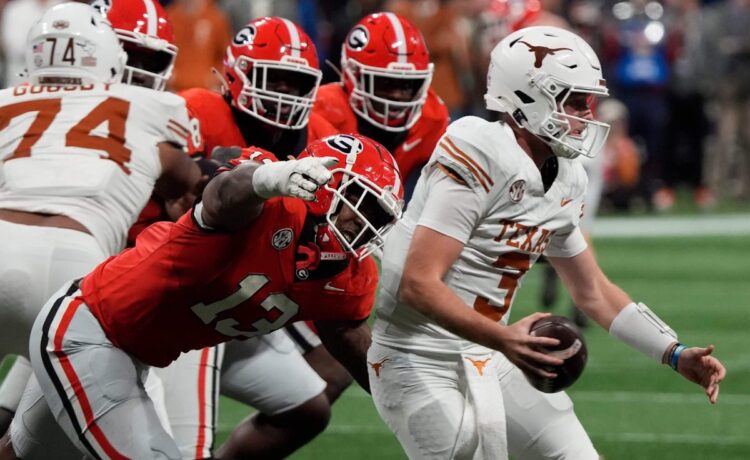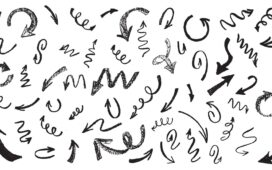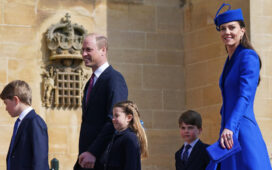Once again, we’ve reached NFL Draft week, so this is the perfect time to reveal our final mock draft for the Chiefs.
As they’ve done the previous seven years, general manager Brett Veach and coach Andy Reid will likely attempt to maneuver the Chiefs up the draft board to help strengthen the roster. The question, though, is the same as always: How do Veach and Reid improve the Chiefs through the draft? The positions of need are clear: defensive lineman, offensive tackle and running back. But the Chiefs enter the draft without a glaring weakness on their roster, which should lead to plenty of intriguing avenues for Veach and Reid to continue building the team.
The Chiefs enter the draft with eight picks, including two in the third round and four in the top 100.
Below are my selections based on many factors, including the positions the Chiefs want to target, the talent in this year’s draft class at various positions and how those prospects will fit within the team’s schemes. While reading this, you should consider Dane Brugler, The Athletic’s NFL draft expert, as my senior director of player personnel. After all, he’s the creator of “The Beast,” his annual draft guide. This year’s edition includes rankings for almost 2,700 prospects and more than 400 in-depth player profiles.
Last month, we published a Chiefs big board, using Brugler’s guide to gain better insight into which prospects appear to be the best fit for the roster.
As always, I uses Pro Football Focus’ mock draft simulator, a fun system that factors in each team’s needs while accounting for the randomness that often occurs in the draft. Estimating and executing trades is included in the process. Unlike our previous mock last month, we altered the simulator’s settings, increasing “care for positional value” more than “draft for needs” while slightly decreasing the “randomness” for the other 31 teams.
Round 1, Pick No. 24: Mykel Williams, DE, Georgia
Trade: The Chiefs trade their first-round pick (No. 31), their original third-round pick (No. 95) and their original 2026 fourth-round pick to the Minnesota Vikings for No. 24, a fourth-round pick (No. 139) and a 2026 fourth-round pick.
You just knew we were going to pull off a trade to move the Chiefs up in the first round. The result of such a deal should be a Chiefs draft room full of cheers, high-fives and grown men screaming, “Yeah!”
Of course, this is an ideal scenario for the Chiefs. Veach has a history of trading up in the first round (see last year for wide receiver Xavier Worthy and 2022 for cornerback Trent McDuffie). Plus, the Chiefs found a perfect trade partner. The Vikings are entering the draft with just four picks, the fewest of any team. Through this trade, the Vikings move down seven spots in the first round and have three picks in the top 100.
Another positive for the Chiefs is that they enter the 2026 draft with two fourth-round picks, one from the Vikings and the other from the Joe Thuney trade to the Bears.
By trading up to 24, the Chiefs can leap over the Houston Texans, the Buffalo Bills and the Baltimore Ravens. PFF’s mock draft simulator estimated that the Chiefs’ trade offer had an 80 percent chance of being accepted.
Acquiring Williams, who is only 20 years old, could be a godsend for Veach, Reid and defensive coordinator Steve Spagnuolo. Williams has plenty of juice when it comes to rushing the quarterback from the edge. Listed at 6-foot-5 and 267 pounds, Williams has the size and frame that Spagnuolo covets in his defensive ends.
One reason Williams might slip a bit in the first round is that he spent much of last season playing through a nagging left ankle injury. But he still earned second-team All-SEC honors last season, recording five sacks, eight tackles behind the line of scrimmage and two forced fumbles.
Williams is ranked as the 21st-best overall prospect, according to Brugler, so the value here makes the trade worthwhile.
“Williams is more toolsy than nuanced and needs to develop a more unified pass-rush plan,” Brugler wrote in “The Beast.” “The individual traits (length, strength, explosiveness), promising toughness and football character, however, are reasons to bet on his upside. Similar in ways to Jason Pierre-Paul, he projects as an NFL starter on the edge.”
So, how did we get here? This mock had a run on receivers (Tetairoa McMillan, Matthew Golden and Emeka Egbuka) and offensive tackles (Will Campbell, Armand Membou and Josh Simmons). Plus, Walter Nolen, the defensive tackle from Ole Miss whom we traded up for to acquire in our previous mock, wasn’t available by the 24th pick. In this mock, Nolen was selected by the Arizona Cardinals with the 16th pick.
At No. 31, the Vikings selected Texas A&M defensive end Nic Scourton.
Other notable prospects potentially available: receiver Luther Burden III (Missouri), defensive tackle Derrick Harmon (Oregon), tight end Colston Loveland (Michigan) and running back Omarion Hampton (North Carolina).
Round 2, Pick No. 63: Tre Harris, WR, Ole Miss
By being patient in the second round, the Chiefs fill a roster need here. At 6-3, Harris appears to be a capable and dependable receiving option for quarterback Patrick Mahomes. Harris has the stride speed to be a factor on the perimeter, too. He should be a fit next to slot receiver Rashee Rice and speedy receiver Xavier Worthy as a true No. 2 receiver who lines up on the perimeter.
In eight games last season, Harris produced 60 receptions for 1,030 yards and seven touchdowns. The best parts of Harris’ game, Brugler said, are his hand-eye coordination and finishing toughness to make catches over defensive backs.
“Harris doesn’t have the explosive speed or separation skills that teams covet in a No. 1 receiver, but he is a controlled athlete with the play strength and ball skills to be a dependable possession target.” Brugler wrote of Harris, whom he graded as the 65th-best prospect.
Other notable prospects potentially available: running back Quinshon Judkins (Ohio State), running back Dylan Sampson (Tennessee), defensive end Josaiah Stewart (Michigan) and defensive tackle Shemar Turner (Texas A&M).
Round 3, Pick No. 69: Alfred Collins, DT, Texas
Trade: The Chiefs trade a third-round pick (No. 66), a fourth-rounder (133) and a seventh-rounder (No. 251) to the New England Patriots for No. 69, a fourth-round pick (106) and a 2026 fourth-round pick.
After trading up in the first round, we have our trade down here in the third round. The motivation for this deal was to gain the Patriots’ fourth-round pick; that way, the Chiefs can still select four players in the top 106 picks. PFF’s mock draft simulator estimated that the Chiefs’ trade offer had a 78 percent chance of being accepted.
With the 66th pick, the Patriots selected Judkins, a running back the Chiefs could also target in the draft.
For the Chiefs, the decision was between Collins and Boston College right tackle Ozzy Trapilo, whom we selected in the third round of our previous mock. The difference-maker is that Collins is expected to play more snaps as a rookie than Trapilo, who would likely learn behind veteran right tackle Jawaan Taylor. Plus, Brugler ranks Collins (No. 68) higher than Trapilo (No. 79).
“Collins is still learning how to maximize his size and talent, but he took a sizable jump this past season and shows the physical traits to be a disruptive force, especially against the run,” Brugler wrote. “He will provide immediate depth as a rookie, and his snap count should increase with experience.”
Another reason to select Collins is this: The Chiefs have only one defensive tackle on their salary-cap sheet for 2026 — Chris Jones.
Other notable prospects potentially available: tight end Mason Taylor (LSU), linebacker Chris Paul Jr. (Ole Miss), offensive tackle Marcus Mbow (Purdue) and defensive end Oluwafemi Oladejo (UCLA).
Round 4, Pick No. 106: Trevor Etienne, RB, Georgia
The Chiefs need a young, dynamic running back. Remember, Mahomes accounted for 72.5 percent of the offense’s yards last season, the most of any quarterback. Another reason the Chiefs should consider selecting a running back is that they don’t have a capable player at the position under contract for the 2026 season.
Keep this 2024 quote from Veach in mind when considering running back prospects: “If you’re a running back for Coach (Andy) Reid, it’s a lot of fun because you have to be a better receiver than a runner to play in his offense. Brian Westbrook was the pinnacle.”
Etienne, the younger brother of Travis, who plays for the Jacksonville Jaguars, offers plenty of speed and versatility.
“Large, accepting hands as a receiving target — rarely let a pass hit the ground,” Brugler wrote of Etienne. “Overall, there might not be anything exceptional about Etienne’s game, but he also doesn’t have any glaring weaknesses that would keep him from seeing steady NFL snaps. His promise as a pass catcher and blocker gives him value on all three downs.”
Other notable prospects potentially available: receiver Tory Horton (Colorado State), running back Devin Neal (Kansas), tight end Harold Fannin Jr. (Bowling Green) and safety Billy Bowman Jr. (Oklahoma).
Round 5, Pick No. 139: Zy Alexander, CB, LSU
The Chiefs are almost always in the market to add a cornerback. Since 2018, when Veach began leading the Chiefs’ draft efforts, the team has selected plenty of cornerbacks who either grew up in a state or played for a college that is below the Mason-Dixon line — L’Jarius Sneed, Joshua Williams, Jaylen Watson, Rashad Fenton, Thakarius Keyes and Kamal Hadden.
The 6-1 Alexander allowed just 43.5 percent completions last season after returning from his knee injury.
“With his length, Alexander smothers routes early and stays attached in his turn and run to shrink the passing windows for the quarterback,” Brugler wrote. “He pattern matches well and trusts his athletic instincts, although shifty receivers can uncover quickly, and he lacks ideal recovery speed.”
Round 7, Pick No. 226: Luke Lachey, TE, Iowa
Round 7, Pick No. 257: Jalen Travis, OT, Iowa State
Both players have a path to make the Chiefs’ initial roster if they succeed in training camp and the preseason. Lachey could even be a nice addition to the practice squad as a developmental player who learns under tight end Travis Kelce. Brugler believes Lachey is willing to do the dirty work in the run game as a blocker.
As Mr. Irrelevant, Travis is a developmental prospect who could one day be a solid left tackle. If everything goes well for Travis, he could be the final offensive lineman on the Chiefs’ initial 53-man roster.
(Photo of Mykel Williams: Joshua L. Jones / USA Today Network via Imagn Images)




